■ Water market in Japan
Since launching on the commercial market in the early 1970s, increasing demand for clean, delicious water and interest in the beauty and health benefits of water has propelled the mineral water market to continuous growth to a point where it is now a part of peoples’ everyday lives. The Japanese market, which grew following the Great East Japan Earthquake, saw more growth in 2014 that pushed it to record levels.
Recent years have seen sparkling water and flavored water permeate into the casual lifestyle scene. According to our statistics, the markets for both of these segments have seen a dramatic four to five-fold growth over the last five years. The expanding mineral water market and the rapid growth of the sparkling water and flavored water markets are factors that are working to drive growth of the overall drinking water market.
■ Results of 2015 consumption trends
| <Mineral water> |
| ◆ |
Perhaps due to the economic environment, the market saw an increase in tap water use and trends towards lower-cost products but overall mineral water usage rates remain highest among drinking waters. |
| ◆ |
Beyond drinking water, the use of mineral water for everyday uses such as making tea and making rice is expanding. We are now seeing the same needs in mineral water delivered to the home. |
| <Sparkling water> |
| ◆ |
Similar to last year, sparkling water consumption was high and the number of repeat buyers is growing. Sparkling water has become a vital part of our lives. |
| <Flavored water> |
| ◆ |
While consumption rates declined slightly compared to last year, the number of repeat buyers of flavored water is on the rise and we are seeing increased diversity in consumption styles. At the same time, given the large number of consumers who have never tried flavored water products, there appears to be significant room for continued market growth. |
This is the 2015 edition of the consumer drinking water trends survey that Suntory has conducted since 1991. The following is a report on the current state and future outlook on consumer trends for mineral water as well as sparkling water and flavored water.
I. Consumer trends survey
| State of mineral water and other drinking water consumption |
1. Survey overview
Today, mineral water has become a vital part of our daily lives.
Suntory Beverage & Food Limited (SBF) has conducted market trend surveys annually since 1991 for the purpose of analyzing how mineral water is consumed as well as consumption frequency, motivation, and preferences. Since 2003, the scope of this survey has no longer been limited to people who drink mineral water at home. The survey scope includes all consumers and covers consumer mentality and style of use for all drinking waters, which includes mineral water. Furthermore, since 2010, the survey method was changed from direct interviews to internet-based surveys.
Drinking water market trend survey
1. Survey target
Targeted individual men and women age 20 – 69 living in the Metropolitan region (Tokyo, and Kanagawa, Chiba, Saitama prefectures) and Kansai region (Osaka, Kyoto, Hyogo, and Nara prefectures) who have purchased one of the following six types of waters or who used tap water as “drinking water” since May of last year.
a) Mineral water (non-carbonated, non-sweetened water sold in PET bottles, cans, or bottles)
b) Carbonated water or sparkling water
c) Flavored water
d) Mineral water home delivery services (in-home water server)
e) Supermarket and other self-service water filling stations
f) In-home water purification (water from alkaline ion water purifiers installed directly on the water pipe)
2. Survey size
500 people (253 men, 247 women)
3. Survey method
Internet questionnaire
4. Survey period
April 25 – April 27, 2015
An overview of survey results is as follows.
2. Major survey results
| (1) Drinking water consumption rates over the past one year |
| - |
Rate of mineral water consumption was highest at 86.0%.
Increase in number of people responding that mineral water was their most frequently consumed drinking water.
|
| (2) Concerns when drinking/using mineral water |
| - |
Concerns when drinking/using mineral water included price, taste, and safety. Similar to last year, price was the greatest concern. |
| (3) Uses of mineral water |
| - |
In addition to drinking as is, use as water for making tea and water for making rice also increased. The use of mineral water in everyday lifestyle is increasing. |
| (4) Perceived places/ideal images of source for mineral water |
| - |
Place thought of as source for mineral water is the Minami-Alps. Preferred location is a place with a vast forest protecting the water source. |
| (5) Reasons for using mineral water home delivery services (water servers) |
| - |
Reasons for use of mineral water home delivery services include convenience as well as peace of mind, and taste. This was particularly apparent among consumers with children. |
| (6) Uses for mineral water home delivery services |
| - |
With mineral water home delivery services as well, there was an increase in use as water for making tea and water for making rice. Use in everyday lifestyle is increasing. |
| (7) Rate of consumption and uses of sparkling water |
| - |
Similar to last year, over half of respondents reported consuming sparkling water. One out of three consumers reported an increase in consumption volume compared to last year. 40% reported enjoying use in drink recipes. |
| (8) Concerns when choosing sparkling water |
| - |
Concerns when drinking/using sparkling water include price, flavor, and carbonation strength with price and flavor rising compared to last year. |
| (9) Situations involving sparkling water consumption |
| - |
The most common response was the consumption of sparkling water while relaxing. Compared to last year, the number of people consuming during short periods of free time, such as while during household chores, increased. |
| (10) Rate of consumption and uses of flavored water |
| - |
Approximately 40% reported consuming flavored water. Nearly 30% of consumers reported an increase in consumption compared to last year. With nearly 40% reporting never having consumed a flavored water, a future increase in consumers can be expected. |
| (11) Concerns when drinking flavored water |
| - |
Concerns when drinking flavored water included flavor selection and taste of the actual water. |
| (12) Situations involving flavored water consumption |
| - |
There was an increase in consumers drinking flavored water when relaxing, before bed, during meals, etc. |
| (13) Situations involving drinking water consumption |
| - |
Mineral water is used in all types of daily lifestyle situations. Sparkling water and flavored water are seeing growing diversity in consumption styles, with a particular increase in consumption while relaxing. |
3. Detailed survey results
(1) Drinking water consumption rates over the past one year
Rate of mineral water consumption was highest at 86.0%.
Increase in number of people responding that mineral water was their most frequently consumed drinking water. |
Regarding the seven types of drinking water - mineral water (non-carbonated, non-sweetened water sold in PET bottles, cans, or bottles), carbonated water or sparkling water, flavored water, mineral water home delivery services, supermarket and other self-service water filling stations, in-home water purification, and tap water – we researched consumption rates (rate of consumption/use) for the past one year. Results showed that mineral water had the highest rate of use at 86.0%. Perhaps due to the economic environment, consumption rates of tap water rose slightly compared to last year but consumption rates of mineral water, sparkling water, and flavored water remained high (Figure 1).
And over the past year the number of people responding that mineral water was their most frequently consumed drinking water was approximately 40% (39.0%). This is nearly 6 points higher than last year, indicated that the value of mineral water is growing among consumers (Figure 2).
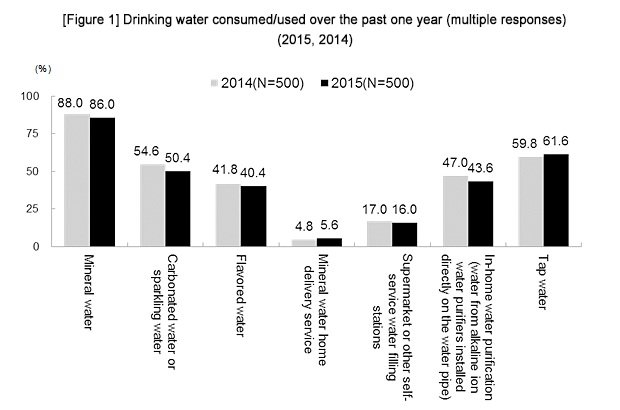
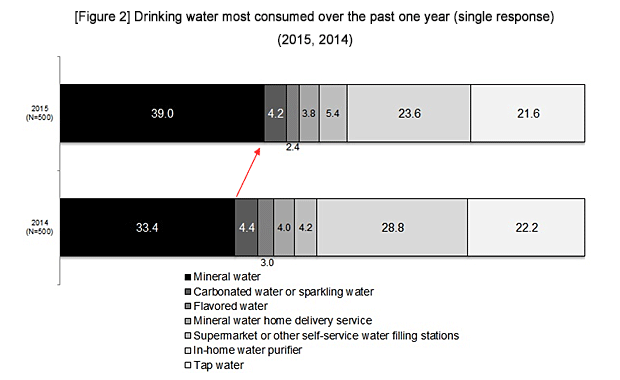
(2) Concerns when drinking/using mineral water
Concerns when drinking/using mineral water include price, taste, and safety.
Similar to last year, price was the greatest concern. |
Next, we asked about consumer concerns when drinking/using mineral water.
The largest number of people were concerned about “price” (64.5%) while “taste” (46.4%), “safety” (40.1%), and “quality” (35.3%) were also among top concerns. Compared to results from 2014, there has been no noticeable change in the rankings of each subject. Just as last year, price remains the greatest concern among consumers. Perhaps due to the economic environment, there appears to be a transition towards greater price awareness (Figure 3).
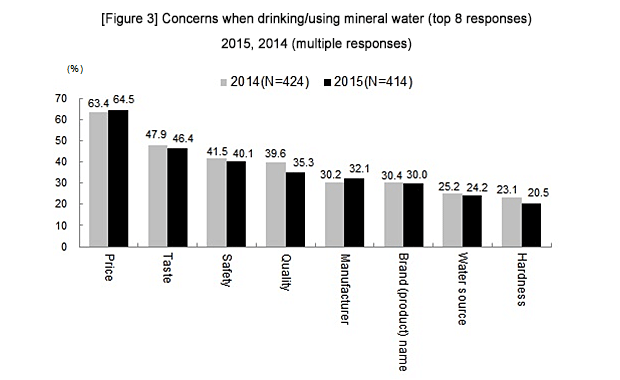
(3) Uses of mineral water
| In addition to drinking as is, use as water for making tea and water for making rice also increased. The use of mineral water in everyday lifestyle is increasing. |
We asked survey participants how they use mineral water.
The main use was “drink as is” (95.2%) but compared to results from 2014, “making green tea, coffee, and black tea” and “making rice” increased. The use of mineral water appears to be expanding beyond drinking water to include daily lifestyle uses (Figure 4).
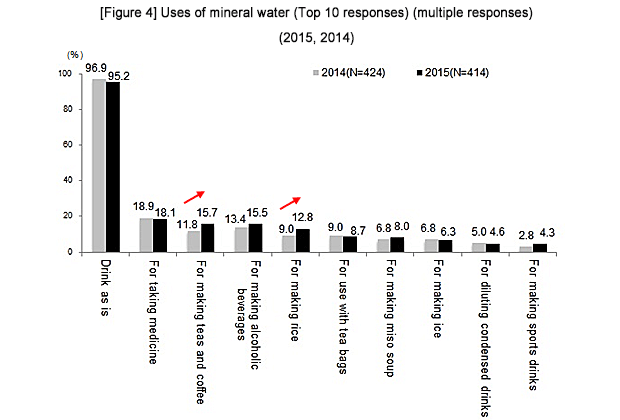
(4) Perceived places/ideal images of source for mineral water
Place thought of as source for mineral water is the Minami-Alps.
Preferred location is a place with a vast forest protecting the water source.
|
We asked mineral water consumers the place that comes to mind when they imagine location from which mineral water is sourced. Again, the Minami-Alps (Yamanashi Prefecture) was No. 1 in 2014. This year as well, over 90% of consumers envision the Minami-Alps as the location from which mineral water is drawn. This marks the third consecutive year at No. 1 since we began conducting this survey in 2013 (Figure 5).
As for the preferred location for drawing mineral water, three out of four people responding that this was “a place with a vast forest protecting the water source” (74.6%). Over half responded, “the forest protecting the water source is protected” (50.8%), which exceed those who responded “the environment of the entire water source area is being conserved” (42.6%). Rather than a general image of environmental conservation, consumers place greater importance on the forest of the water source (Figure 6).
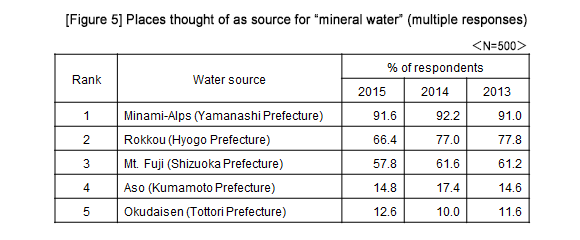
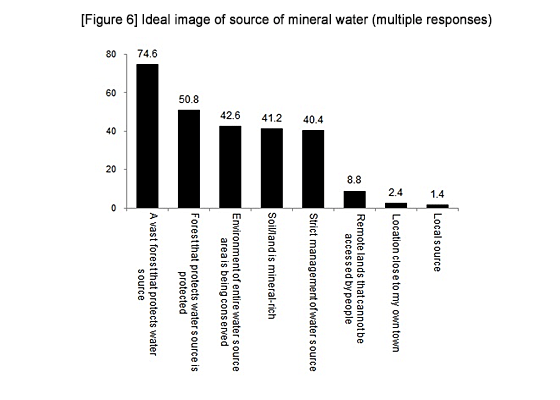
(5) Reasons for using mineral water home delivery services (water servers)
Reasons for use of mineral water home delivery services include convenience as well as peace of mind, and taste.
This was particularly apparent among consumers with children. |
We asked respondents using mineral water home delivery services their reasons for use.
“Because they deliver to my home” (37.3%), “for the peace of mind” (34.3%), and “because it tastes good” (31.3%) were the top three reasons.
Among consumers with children who used mineral water home delivery services, “for the peace of mind” (41.7%) was the No. 1 reason. Comparing consumers with children against all users, “because it is natural water” (consumers with children - 27.8%; all users - 16.4%), “because of the reasonable price” (consumers with children - 22.2%; all users - 11.9%), and “because of the peace of mind” (consumers with children - 41.7%; all users - 34.3%) were highest. This indicates that consumers with children use mineral water home delivery services not only because of the convenience, but also because of personal water preferences and price (Figure 7).
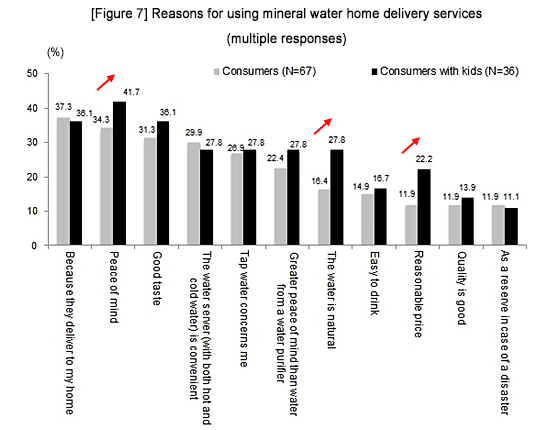
(6) Uses of mineral water home delivery services
With mineral water home delivery services as well, there was an increase in use as water for making tea and water for making rice.
Use in everyday lifestyle is increasing. |
We asked consumers about how they use mineral water home delivery services. For mineral water home delivery services as well, “drink as is” (88.1%) was the main type of use but, compared to results from 2014, “making rice,” “mixing with alcohol”, “making ice,” and “making green tea, coffee, and black tea,” etc., show an increase in use for such reasons.
Similar to mineral water (PET bottles, etc.), the use of mineral water home delivery services is expanding to include daily lifestyle uses (Figure 8).
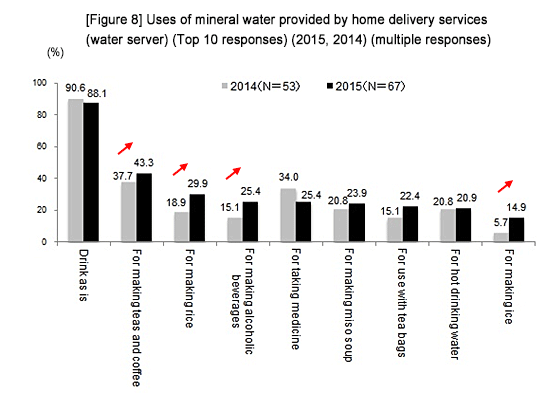
(7) Rate of consumption and uses of sparkling water
Similar to last year, over half of respondents reported consuming sparkling water.
One out of three consumers reported an increase in consumption volume compared to last year. Over 40% reported enjoying use in drink recipes. |
During the past year, the percentage of people who consumed sparkling water was at 50.4%, indicating a continuing trend of representing more than half of consumers (Figure 9).
In response to the question of how their consumption changed over the past year, 33.7% indicated that consumption increased, which greatly outpaced those who responded that consumption decreased (9.1%) (Figure 10).
We also asked those who indicated consuming sparkling water about their rate of consumption. 21.6% responded that they drink sparkling water often and 46.6% responded that they drink it “occasionally.” Combined, this represents 68.2% of all respondents, which greatly outpaces the combine 31.8% of people who responded “not often” (18.8%) or “hardly ever” (13.0%). This indicates that are a large number of people who repeatedly consume sparkling water (Figure 11).
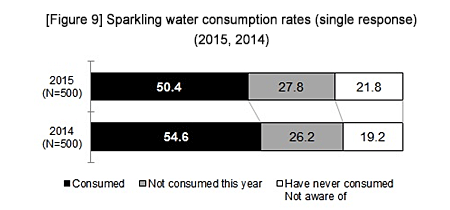
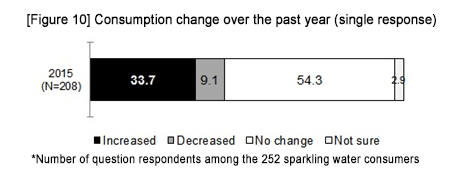
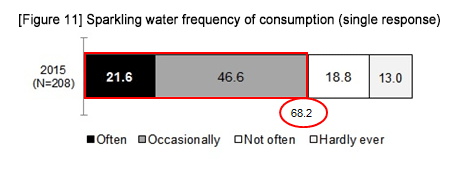
We asked people who consume sparkling water about how they drink it. 82.7% responded “drink as is” and 42.8% responded “use it as a mixer.” Of those using it as a mixer, the vast majority (71.9%) responded that they mixed it with alcohol. However, with responses such as "mixing with fruit juice and other non-alcoholic beverages" (28.1%) and "mixing with dark vinegar or fruit vinegar" (15.7%), we see that there are consumers enjoying using sparkling water as part of a beverage recipe (Figure 12, Figure 13).
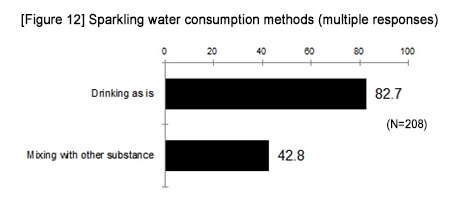
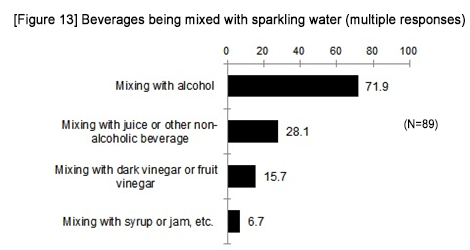
(8) Concerns when choosing sparkling water
| Concerns when drinking/using sparkling water include price, flavor, and carbonation strength with price and flavor rising compared to last year. |
We asked people who consumed/used sparkling water about their concerns when drinking sparkling water. The top responses were “cheap price” (39.4%), “flavor” (37.5%), and “carbonation strength” (37.0%). Compared to last year, there was an increase in the percentage of consumers prioritizing “cheap price” and “flavor” (Figure 14).
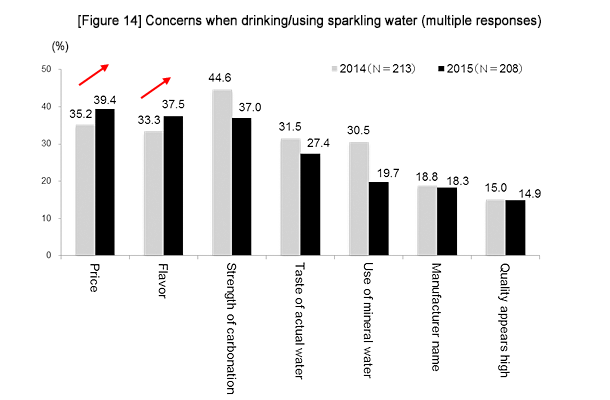
(9) Situations involving sparkling water consumption
| The most common response was the consumption of sparkling water while relaxing. Compared to last year, the number of people consuming during short periods of free time, such as while during household chores, increased. |
We asked about the types of situations in which people drink sparkling water. The top responses were “while relaxing” (33.2%), “when drinking alcohol” (25.5%), and “after bathing” (23.6%). Compared to last year, there was an increase in the percentage of people who consumed sparkling water “while doing household chores,” and “during work/class.” This would indicate that the number of people consuming sparkling water during short periods of free time in their daily schedules is increasing (Figure 15).
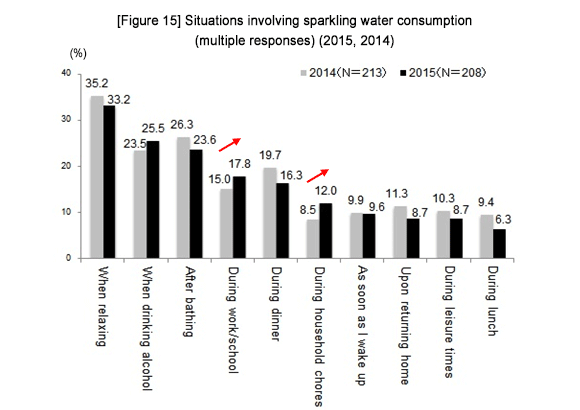
(10) Rate of consumption and uses of flavored water
Approximately 40% reported consuming flavored water.
Nearly 30% of consumers reported an increase in consumption
compared to last year. With nearly 40% reporting never having consumed
a flavored water, a future increase in consumers can be expected. |
During the past year, the percentage of people who consumed flavored water was 40.4%. On the other hand, 34.6% reported never having consumed or not knowing about flavored water. Considering the large number of consumers unfamiliar with the products, compared to the sparkling water market the flavored water market appears to have yet significant growth potential (Figure 16).
We asked people if they thought their volume of consumption had decreased. With 31.7% thinking their consumption had “increased,” this exceeds the percentage of people who thought their consumption “decreased” (6.9%) (Figure 17). We also asked those who indicated consuming flavored water about their rate of consumption. 9.4% responded that they drink sparkling water “often” and 49.0% responded that they drink it “occasionally.” Combined, this represents 58.4%, or more than half of all respondents (Figure 18).
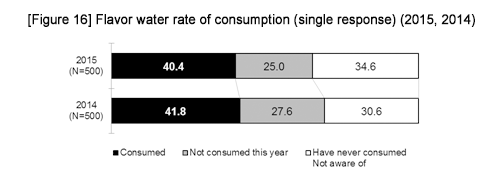
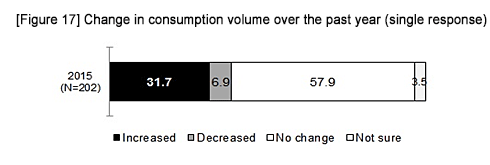

We asked respondents who consume flavored water about their reasons. “Because it tastes good” was the greatest response (47.5%) with other responses including “because it is refreshing” (40.1%), and “because it is easy to drink” (37.1%).
Compared to last year, “because it tastes good,” and “because it is easy to drink” both increased, indicating that consumers prefer and are choosing a great taste that is easy to drink (Figure 19).
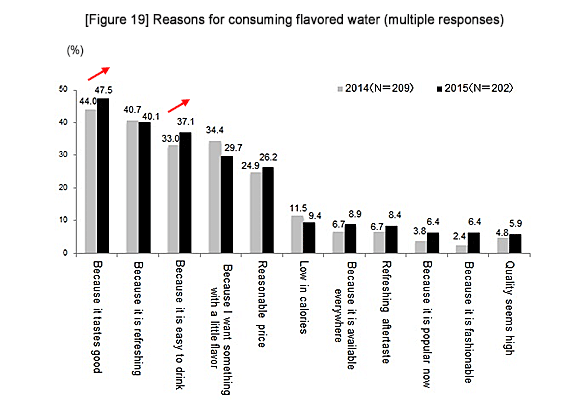
(11) Concerns when drinking flavored water
Concerns when drinking flavored water included flavor selection and
taste of the actual water. |
We asked those who indicated consuming flavored water about their concerns when drinking flavored water. “Taste of flavor” (66.8%) was the greatest response followed by “taste/flavor of the actual water” (32.2%), “mineral water is being used” (23.8%), and “cheap price” (22.8%). This represents no significant change from last year (Figure 20).
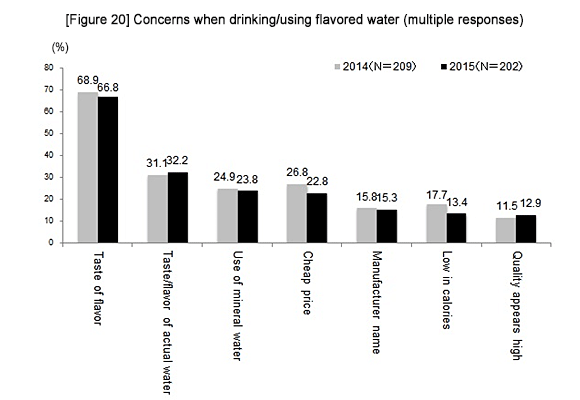
(12) Situations involving flavored water consumption
There was an increase in consumers drinking flavored water
when relaxing, before bed, during meals, etc. |
We asked about situations in which people consume flavored water. “When relaxing” (32.7%) was the No. 1 response. Compared to last year, reasons such as “when relaxing,” and “before going to bed” are rising, indicating increased consumption during both lunch and dinner. There appears to be an increase in the consumption of flavored water during relaxing situations and meals (Figure 21).
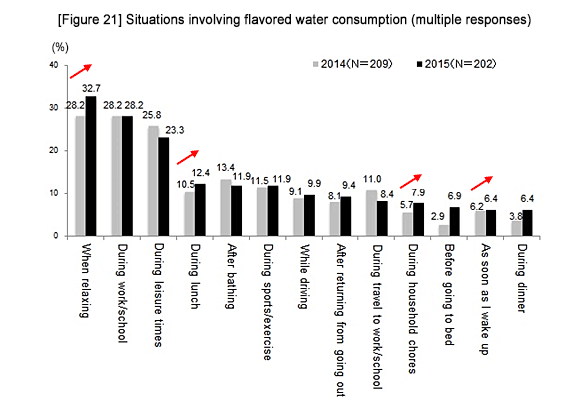
(13) Situations involving drinking water consumption
| Mineral water is used in all types of daily lifestyle situations. Sparkling water and flavored water are seeing growing diversity in consumption styles, with a particular increase in consumption while relaxing. |
A ranking of consumption styles for each beverage type is as follows.
Mineral water is consumed “right after waking up” (38.4%), “after bathing” (32.1%), “during work/school” (29.2%), etc. It is consumed it a variety of everyday lifestyle situations.
Both sparkling water and flavored water are consumed most by people “during relaxing situations” (33.2%, 32.7%). Sparkling water is consumed “when drinking alcohol” (25.5%) and “after bathing” (23.6%). This indicates a trend towards consuming during relaxing situations in the evening. On the other hand, flavored water consumption situations include “during work/school” (28.2%), and “during leisure time” (23.3%), etc. Both indicate a trend towards consumption during active times in afternoon (Figure 22).
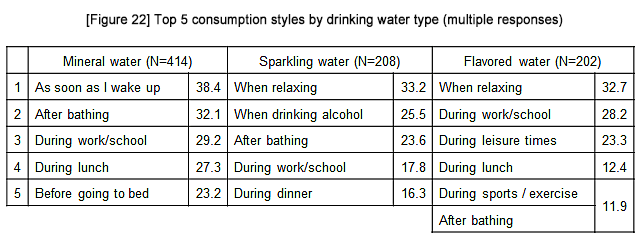
II. Reference: About transitions in the Japanese water market
<About the mineral water market>
The history of mineral water in Japan dates back to the early 1970s when bottled mineral water was first sold on the commercial market. While reflecting the various elements of the times, mineral water has gradually permeated into the Japanese lifestyle over the years.
●Late 1980s: Growth of the general consumer market
Increased familiarity of mineral water driven by the natural and healthy living trends as well as increase overseas travel by Japanese people and growing concerns related to the quality of tap water caused a transition in growth from the commercial to the general consumer market.
●1990s: Major growth in general consumer market
Entering the 1990s, news media began to report on the cleanliness of apartment building water tanks and issues with tap water. These reports sparked an increase in the consumption of mineral water among general consumers. Domestic mineral water grew as an alternative to tap water and a boom in 1993 also saw import volume grow.
An extremely hot summer and water shortage in 1994 resulted in increased demand and increased awareness about the need for emergency reserves. These factors helped establish mineral water’s position as a household product.
However, imported mineral water decreased dramatically following a contamination scandal in autumn 1995 and in 1996 the consumer mineral water market sales underperformed previous year sales for the first time in the 1990s. However, this incident created a higher level of consumer awareness regarding mineral water safety as quality reliability became the key impetus for consumer purchases.
In April 1996, Japan allowed the sale of domestically produced small-volume PET bottle products. This increased occasions for mineral water consumption and resulted in a significant increase in volumes of domestic mineral water.
The so-called “Y2K Problem” caused many people to stock mineral water in their homes out of concerns about power outages and mineral water sales in 1999 increased by 30% compared to the previous year.
●2000s: Market growth with increase in health consciousness, market achieves record growth in 2014
From 2000 to 2006, increase health consciousness drove the growth in the mineral water market but from 2007 the market was stagnant due in part to consumer pessimism. In 2011, the sudden demand for reserves seen following the Great East Japan Earthquake with sales jumping from 3,172,000 kiloliters (year on year increase from 126.0%). This was represented an 11-fold increase over twenty years ago and a 2.5-fold increase compared to 10 years ago. (Figure 23: according to Mineral Water Association of Japan research)
In 2014, domestic mineral water production volume increased (domestically produced mineral water = 2,917,000 kiloliters, YoY 101.8%) and volume of imported mineral water decreased (imported mineral water = 343,000 kiloliters, YoY 88.1%). However, the market total of 3,261,000 kiloliters represent and record high.
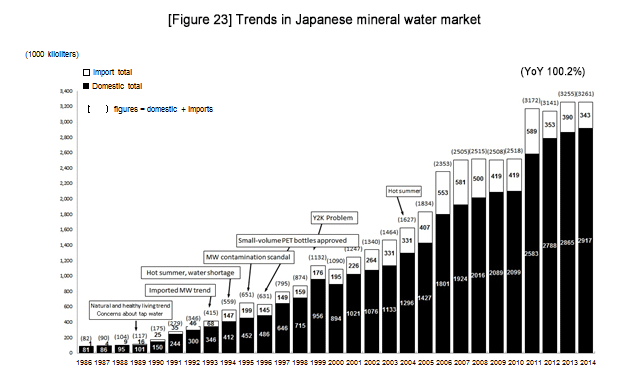
●Japanese domestic per capita annual consumption trends
From 2007, Japanese domestic per capital annual mineral water consumption held steady at around 19.7 liters. However, in 2011, due in part to the impact of the Great East Japan Earthquake, this grew significantly to 24.8 liters and reached record levels in 2014 at 25.7 liters. (Figure 24: according to Mineral Water Association of Japan research)
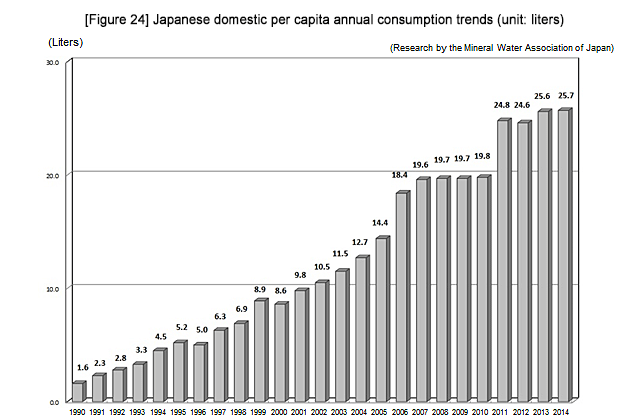
<About sparkling water and mineral water>
Recent years have seen sparkling water and flavored water permeate into the casual lifestyle scene. According to our statistics, the markets for both of these segments have seen a dramatic four to five-fold growth over the last five years. The expanding mineral water market and the rapid growth of the sparkling water and flavored water markets are factors that are working to drive growth of the overall drinking water market.



























